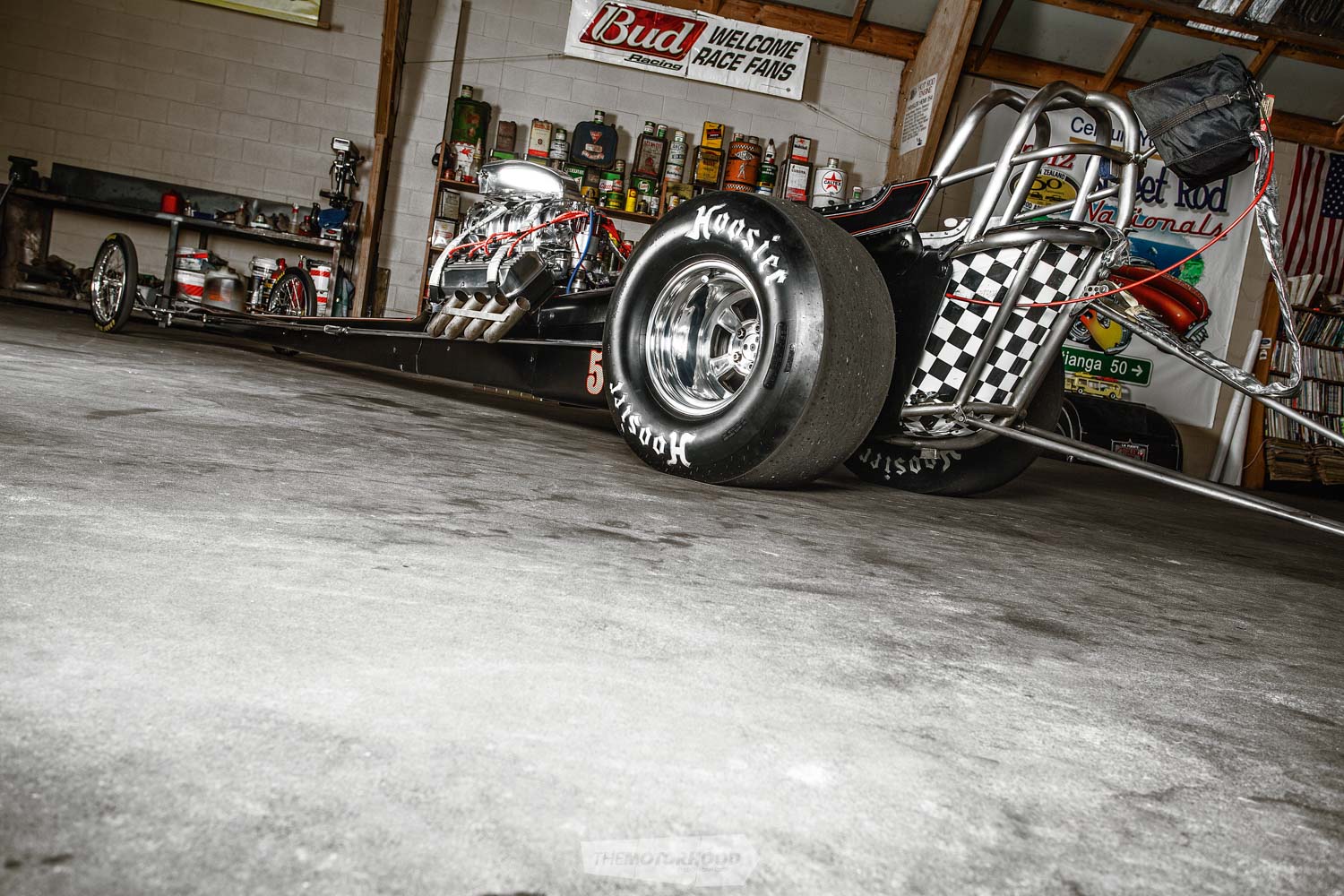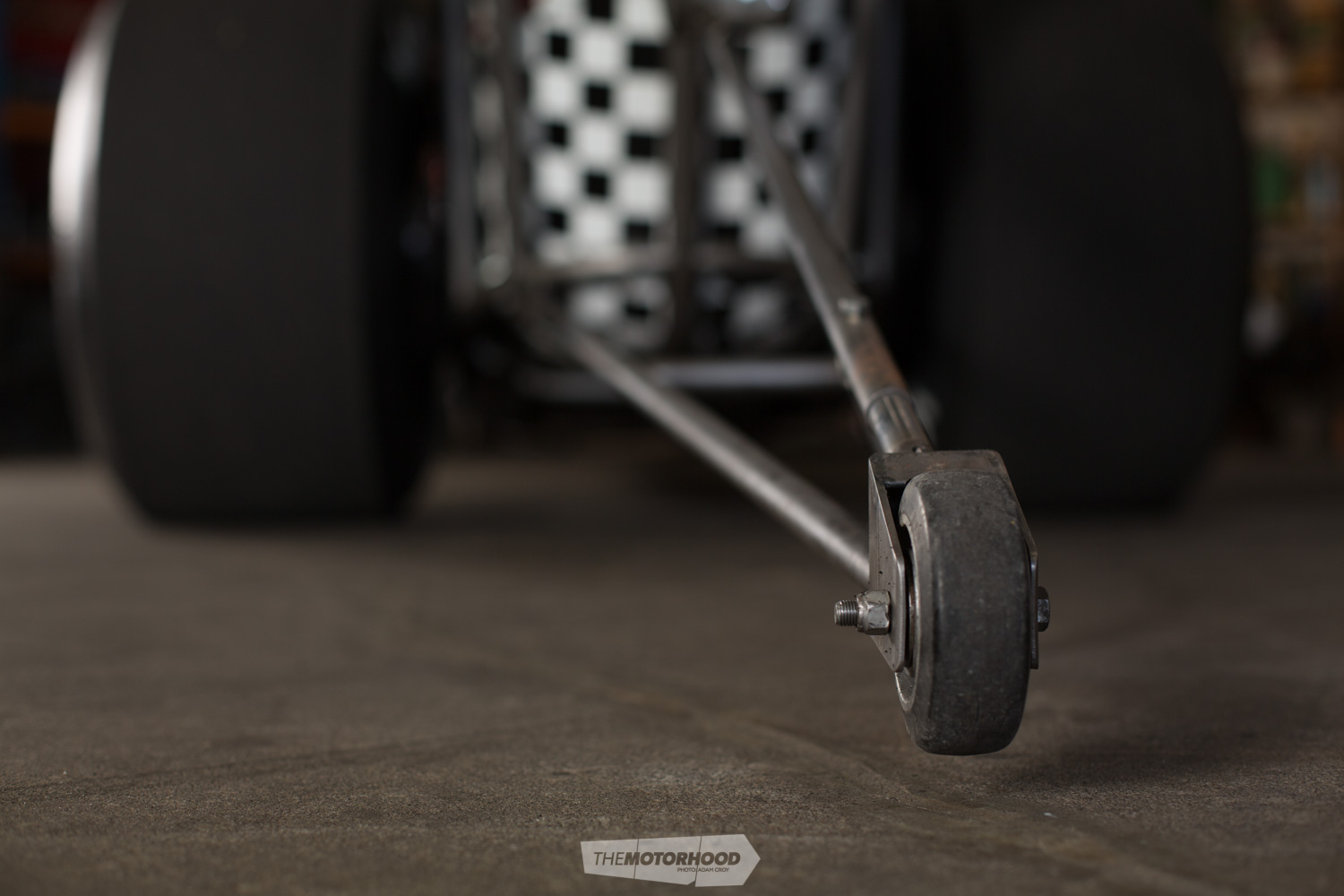While drag racing is all about speed, there’s no rule that says you can’t do it in style!

There’s something about a front-engine dragster (FED) that screams cool. It’s one of those weird phenomena: regardless of whether you know the history behind it, a FED is something special. Of course, if you do know the history — as most hot rodders and drag racers do — then that appeal is taken to a whole new level.
To those with any form of common sense, to sit atop a diff with your legs straddling a transmission and a highly volatile mountain of metal just in front of you is a seriously bad idea. Then again, life would be boring if not for those who push the boundaries of sense. The Smyths are a family who live and breathe hot rodding. Raymond and his two kids, Rachelle and Trent, have been guardians of this beautiful FED — dubbed ‘Blown Income’ — for going on 15 years, and, in that time, hot rodding has turned from a hobby to a full-blown obsession.

Raymond, a long-time hot rodder, caught the drag racing bug back in 1992 when he ran the ex-Unkovich dragster at the Nostalgia Drags with a blown flathead. Colin Prouse, a friend of Raymond’s, was the owner of the car at the time, and knew straight away that Raymond would get hooked — and he did. From there, he went on to crew for Tim Watkins, who ran the well-known Ferrari doorslammer he’d purchased from legendary metal man Terry Sims. While Raymond enjoyed being involved with the doorslammer, he found that crewing just didn’t give him the same buzz as running a car of his own. Looking at the thrill Tim was getting during each run, Raymond realized that there was only one answer: to get a car of his own.
At this time, a friend of Raymond’s, Pete Dore, was building a FED, and he convinced Raymond that he needed to go in the same direction, so they could have a bit of fun racing each other. The car they found was a 1965 Don Tuttle–built 185-inch FED that had previously been powered by an aspirated Hemi but was being sold in America as a roller. Despite being a staunch flathead fan, Raymond knew that, if he wanted to do some real skids, the car needed to be Hemi powered again. Once the car landed, it wasn’t long before a 354ci motor was built, and the car then hit the track, running an impressive 8.2 at 157mph. Even away from the track, the car was fired up at every opportunity available, much to the delight of Rachelle and Trent and the disgust of the neighbours.

Over the next decade, the car entertained various engine combos, including a Mike Gearing–built 354ci Hemi, which pushed the car to a best of 7.5 at 182mph. However, that was still considered not fast enough and a 417ci Donovan Hemi was purchased off Faye Grant. It helped get the car to an impressive 7.2-second pass at 195 mph, which, for a change, was actually more than enough. In fact, after one too many hair-raising runs, the engine was pulled and the 354 dropped back in, as the decision was made to slow the car down a touch for safety.
However, a few years ago, Raymond’s love of out-of-control passes returned, and he decided that if he were ever to crack the magic six-second and 200mph barriers, then now was the time to do it — while he was still young and foolish enough to try. By then, Trent was also driving the car, and there was no such thing as ‘too fast’ for him — especially when he wasn’t the one paying for the motor. With Raymond’s goal in mind, an engine was imported out of the States that, in theory, would cut the mustard. Sadly, it wasn’t all it was meant to be and needed a major overhaul once it arrived. Local engine builder Murray Smith, from Papakura Engine Specialists, was called in to help transform the engine into a combo that would not only run the magic numbers but would also do so reliably.

“He decided that if he were ever to crack the magic six-second and 200mph barriers, then now was the time to do it”
The bones of the new build would be the 1957 392ci Hemi block that had come from abroad, but this time it would be filled with a Velasco 4½-inch billet crank, Mickey Thompson alloy rods, and Arias 10.5:1 forged pistons, resulting in a total displacement of 436ci. With ARP fasteners used throughout, along with a Milodon high-volume oil pump and sump, the bottom end has been built — hopefully — to be trouble-free, even though it’ll be withstanding in excess of 1500hp.
In true nostalgia style, the set-up runs 1956 Hemi heads sourced from a 354ci engine — although, apart from the heavily ported head castings themselves, there’s nothing vintage about it. Instead, the heads are filled with stainless triple valve springs along with titanium retainers and locks. So custom is the whole engine set-up that even the valley cover is now a Donovan billet item. Above this sits an Edelbrock manifold, which supports a BDS 10-71 supercharger running 30-per-cent overdrive and topped with a Hilborn Shotgun injector set-up. The engine is bolted to a Chuck Mann–prepped Powerglide, which is as strong as the motor itself, thanks to all sorts of internal trickery. With a 2500rpm stall converter and transbrake, the car truly does appear to slingshot off the start line.

Bolted almost directly to the trans, with just a coupler in place of a driveshaft, is a custom-fabricated nine-inch diff housing filled with a spool and 35-spline axles along with a 3.5:1 ratio. Just as it was in the cars when they were originally raced, there’s no such thing as suspension in the rear, with the diff being connected directly to the frame. A set of Wilwood discs and calipers may be a departure from tradition, but these do help with slowing the car from the 190-mile-per-hour-plus passes it regularly makes.
The chassis is not entirely as was when it left the jig back in ’65; during the car’s early years in New Zealand, Terry Sims was called upon to make a few changes. Likewise, he is responsible for the beautifully crafted alloy body panels and custom fuel tank. The aero-styled rear that hides the 1960s Deist 16-foot ribbon chute is a true work of art, as is the pointed nose cone. For many years, the car was run in bare-metal guise, but, prior to last season, the decision was made to give it a new look. Eric Jarman sprayed the whole lot in a Spies Hecker satin black, before Charlie ‘Chaz’ Allen added the finishing touches. Leaving the design up to Chaz, the family knew that he’d come back with something impressive, and he certainly did. So good was the pinstripe work that it was added to the matching satin black helmet and has recently been replicated on the team’s shirts.

There’s a new race suit being added to the collection, too. After years of being involved in running and owning the car, Rachelle is keen to have a skid in it herself. No stranger to driving cool cars, her getting behind the butterfly only adds to the family fun.
While Raymond told us that once he runs a 200mph pass in the car, he’ll pass the driving duties over 100 per cent to Trent and Rachelle, we’re not so sure that’ll happen, as an addiction this strong won’t be an easy one to give up. We’re more convinced that the family will keep on going and keep pushing the car deeper into the six-second zone to see how fast they can really get it to run.

“The family will keep . . . pushing the car deeper into the six-second zone to see how fast they can really get it to run”
The Smyth Family: Raymond, Rachelle, and Trent
Drivers: Raymond and Trent Smyth
Car Club: Papakura Rod and Custom Club
Age: 55 (Raymond), 31 (Rachelle), 28 (Trent)
Occupation: Contractor (Raymond), administrator (Rachelle), project manager (Trent)
Previously owned cars: 1932 Ford Tudor, 1932 Ford flathead roadster, 1939 Ford Tudor, 1932 Ford 427 Chev Roadster, 1959 Ford Ranchero, 1965 Dodge Monaco, 1957 Chevrolet Bel Air, 1962 Ford Fairlane, 1950 Studebaker coupe (Raymond); 1946 Ford coupe, 1987 Chevrolet Corvette, 2005 Ford Mustang (Rachelle); 1966 XP Falcon (Trent)
Dream car: We are all driving them!
Why the dragster? We wanted to do some skids
Build time: Ongoing
Length of ownership: 15 years
The Team thanks: Murray Smith at Papakura Engine Specialists; Chuck Mann for the transmission; Diffs R Us; Charlie ‘Chaz’ Allen for the pinstriping; Terry Sims for body and chassis modifications; Eric Jarman for paint; our crew members Tiffany, Adam Oram, and Couper

1965 Don Tuttle dragster
Engine: 392ci Chrysler Hemi, bored and stroked to 436ci, Velasco 4¼-inch stroker billet crank, Mickey Thompson alloy rods, ARP fasteners, Arias 10.5:1 forged pistons, Milodon four-bolt billet caps, Milodon gear drive, Milodon high-volume oil pump, Milodon sump, Howard flat tappet cam, Chilled Iron lifters, chromoly push rods, 1956 Chrysler 354 heads, stainless alloy triple valve springs, titanium retainers and locks, Edelbrock blower manifold, Donovan billet alloy valley cover, BDS 10-71 supercharger; 30-per-cent overdrive, BDS 14mm belt, Hilborn Shotgun injector, Enderle 110 fuel pump, custom-fabricated fuel tank; Mallory Super Mag; Mallory leads; Hedman headers
Driveline: Powerglide transmission, 2500rpm stall converter, transbrake, extra clutches, Kevlar band, JW Performance SFI flexplate, custom-fabricated nine-inch Ford diff, 35-spline billet axles, Strange engineering head, full spool, 3.5:1 Richmond gears, Pro Floater floating hubs
Suspension: Torsion bar front, solid rear
Brakes: Wilwood discs and calipers, Wilwood master cylinder
Wheels/Tyres: 22 x 2.5-inch Hayden Enterprises wire front wheels, 15 x 10-inch three-piece Arrow Halibrand rear wheels, 22 x 2.5 Goodyear Frontrunners, 33 x 12 x 15 Hoosier slicks
Exterior: Custom body, Spies Hecker satin black paint, pinstriping by Chaz Allen, 1960s Deist 16-foot ribbon chute
Chassis: 1965 Don Tuttle chromoly chassis, 185-inch wheelbase, modifications by Terry Sims
Interior: Deist five-point safety harness, custom aluminium and upholstery, butterfly steering wheel, The Frameworks pro shifter, Auto Meter 3.5-inch tach, Auto Meter oil and boost gauges, Moon accelerator pedal
Performance: 7.02s at 194mph
This article originally appeared in the 2014 Hot Rod Special of NZV8 magazine











